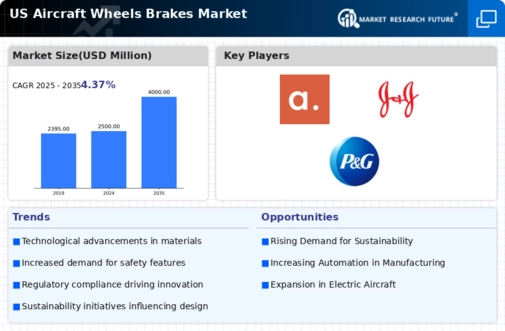Emerging Defense Contracts
The aircraft wires-cables market is also being driven by emerging defense contracts in the US. As military budgets increase, there is a growing emphasis on modernizing aircraft fleets with advanced wiring systems that can support sophisticated avionics and communication technologies. The US Department of Defense has allocated substantial funds for upgrading military aircraft, which is expected to boost demand for high-performance wiring solutions. The defense sector is projected to account for approximately 30% of the total market share by 2026, reflecting the critical role of reliable wiring in military operations. This trend indicates a promising opportunity for manufacturers to engage with defense contractors and develop specialized wiring solutions tailored to military specifications. The aircraft wires-cables market stands to gain significantly from these defense initiatives.
Increased Investment in R&D
The aircraft wires-cables market is benefiting from increased investment in research and development (R&D) by manufacturers. As competition intensifies, companies are focusing on developing innovative wiring solutions that enhance performance and reduce costs. This investment is crucial for creating lightweight, durable, and efficient wiring systems that meet the evolving demands of the aviation industry. In 2025, R&D expenditures in the aerospace sector are expected to reach approximately $15 billion, with a significant portion directed towards advancements in wiring technologies. This focus on innovation not only improves product offerings but also positions manufacturers favorably in a competitive market. The aircraft wires-cables market is likely to see a proliferation of new products and technologies as a result of these R&D efforts, ultimately benefiting end-users and enhancing overall safety and efficiency.
Growth in Commercial Aviation
The aircraft wires-cables market is set for growth, largely driven by the expansion of the commercial aviation sector. With increasing air travel demand, airlines are investing in new aircraft and retrofitting existing fleets with advanced wiring systems. The US commercial aviation market is projected to grow at a CAGR of 4.2% over the next five years, leading to heightened demand for reliable and efficient wiring solutions. This growth is further supported by the introduction of new aircraft models that require advanced wiring technologies to support their complex electronic systems. As airlines seek to enhance passenger experience and operational efficiency, the aircraft wires-cables market is likely to benefit from this upward trend. The anticipated increase in aircraft deliveries and upgrades will create a robust environment for manufacturers in the aircraft wires-cables market.
Technological Advancements in Aviation
The aircraft wires-cables market is experiencing a surge due to rapid technological advancements in aviation. Innovations in materials and manufacturing processes are enhancing the performance and reliability of aircraft wiring systems. For instance, the introduction of advanced composite materials is reducing weight while improving durability. This trend is particularly relevant as the aviation industry aims to enhance fuel efficiency and reduce operational costs. The market is projected to grow at a CAGR of approximately 5.5% from 2025 to 2030, driven by these technological improvements. Furthermore, the integration of digital technologies in aircraft systems necessitates more sophisticated wiring solutions, thereby expanding the aircraft wires-cables market. As aircraft become increasingly reliant on electronic systems, the demand for high-quality, reliable wiring solutions is likely to intensify.
Regulatory Compliance and Safety Standards
The aircraft wires-cables market is significantly influenced by stringent regulatory compliance and safety standards imposed by aviation authorities. In the US, organizations such as the Federal Aviation Administration (FAA) enforce rigorous guidelines to ensure the safety and reliability of aircraft components, including wiring systems. Compliance with these regulations often necessitates the use of high-quality materials and advanced manufacturing techniques, which can drive up costs but ultimately enhance safety. The market is expected to see a steady increase as manufacturers invest in meeting these standards. As of 2025, the market is estimated to be valued at around $3 billion, with a substantial portion allocated to ensuring compliance with evolving safety regulations. This focus on safety not only protects passengers but also bolsters the reputation of manufacturers in the aircraft wires-cables market.














Leave a Comment